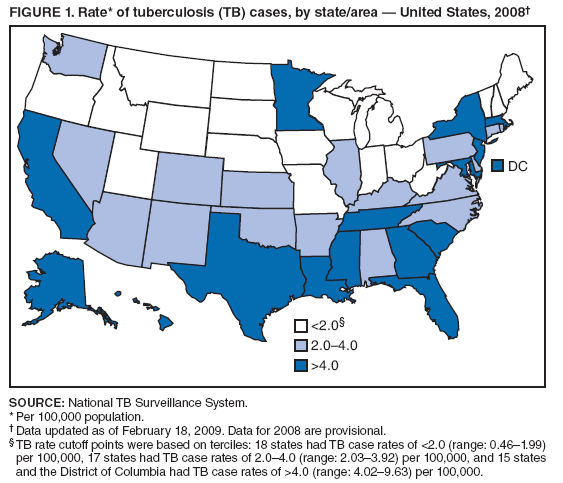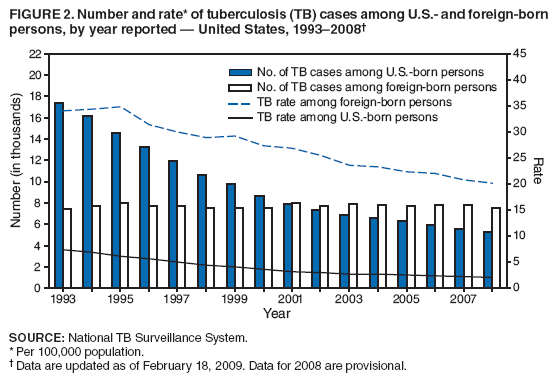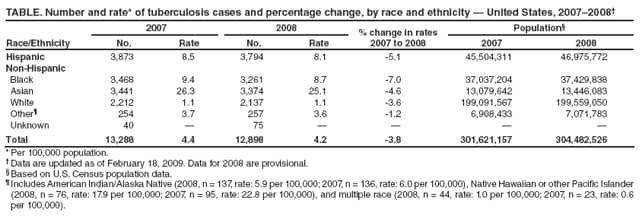 |
|
|
|
|
|
|
| ||||||||||
|
|
|
|
|
|
|
||||
| ||||||||||
|
|
|
|
|
Persons using assistive technology might not be able to fully access information in this file. For assistance, please send e-mail to: mmwrq@cdc.gov. Type 508 Accommodation and the title of the report in the subject line of e-mail. Trends in Tuberculosis --- United States, 2008In 2008, a total of 12,898 incident tuberculosis (TB) cases were reported in the United States; the TB rate declined 3.8% from 2007 to 4.2 cases per 100,000 population, the lowest rate recorded since national reporting began in 1953. This report summarizes provisional 2008 data from the National TB Surveillance System and describes trends since 1993. Despite this overall improvement, progress has slowed in recent years; the average annual percentage decline in the TB rate decreased from 7.3% per year during 1993--2000 to 3.8% during 2000--2008.* Foreign-born persons and racial/ethnic minorities continued to bear a disproportionate burden of TB disease in the United States. In 2008, the TB rate in foreign-born persons in the United States was 10 times higher than in U.S.-born persons. TB rates among Hispanics and blacks were nearly eight times higher than among non-Hispanic whites, and rates among Asians were nearly 23 times higher than among non-Hispanic whites. In 2008, among persons with TB whose country of origin was known, approximately 95% of Asians, 76% of Hispanics, 32% of blacks, and 18% of whites were foreign born. Among U.S.-born racial and ethnic groups, the greatest racial disparity in TB rates was for U.S.-born blacks, whose rate was seven times higher than the rate for U.S.-born whites. Intensified efforts are needed to address the slowing decline in TB incidence and the persistent disparities that exist between U.S.-born and foreign-born persons and between whites and minorities in the United States. Health departments in the 50 states and the District of Columbia (DC) electronically report to CDC verified TB cases that meet the CDC/Council of State and Territorial Epidemiologists case definition.† Reports include the patient's race, ethnicity (i.e., Hispanic or non-Hispanic), treatment information, and, whenever available, drug-susceptibility test results. CDC calculates national and state TB rates overall and by racial/ethnic group using current U.S. Census population estimates. U.S. Census annual estimates were used to calculate the national TB rate and the percentage change from 2007 to 2008. Population denominators used to calculate TB rates and percentage changes over time according to national origin (U.S.-born versus foreign-born persons) were from the U.S. Census Current Population Survey. A U.S.-born person was defined as someone born in the United States or its associated jurisdictions or someone born in a foreign country but having at least one U.S.-born parent. Persons not meeting this definition were classified as foreign born. For 2008, patients with unknown origin of birth represented 0.6% (74 of 12,898) of total cases. For this report, persons identified as white, black, Asian, American Indian/Alaska Native, native Hawaiian or other Pacific Islander, or of multiple races were all classified as non-Hispanic. Persons identified as Hispanic might be of any race. In 2008, TB rates in the 51 reporting areas ranged from 0.5 (North Dakota) to 9.6 (Hawaii) cases per 100,000 population (median: 3.0 cases per 100,000 population) (Figure 1). Thirty-three states and DC had lower rates in 2008 than in 2007; however, 17 states had higher rates. Four states (California, Florida, New York, and Texas) reported more than 500 cases each for 2008, a decline from seven states with at least 500 cases in 2006 and five states in 2007. Combined, these four states accounted for approximately half (49.2% [6,349]) of all TB cases in 2008. Among U.S.-born persons, the number and rate of TB cases continued to decline in 2008. The number of TB cases in U.S.-born persons (5,283 [or 41.2% of all cases in persons with known origin]) declined 3.9% compared with 2007 and 69.7% compared with 1993 (Figure 2). In 2008, the TB rate among U.S.-born persons was 2.0 per 100,000 population, representing a 4.7% decline since 2007 and a 72.6% decline since 1993. Blacks (42.2% [2,227 of 5,283]) had the highest number of TB cases among U.S.-born persons. Among foreign-born persons in the United States, both the number and rate of TB cases declined in 2008. A total of 7,541 TB cases were reported among foreign-born persons (58.8% of all cases in persons with known origin), a 2.8% decrease from the 7,757 cases reported in 2007. The TB rate among foreign-born persons in 2008 was 20.2 per 100,000 population, which was a 2.6% decline since 2007 and a 40.6% decline since 1993. In 2008, four countries accounted for approximately half (50.1%) of foreign-born TB cases: Mexico (1,742), the Philippines (855), India (598), and Vietnam (580). In 2008, more TB cases were reported among Hispanics than any other racial/ethnic group, followed by Asians and blacks (Table). Asians had the highest TB case rate among all racial/ethnic groups. From 2007 to 2008, TB rates declined for all racial/ethnic minorities. The greatest annual decline in TB rate was among blacks (-7.0%), followed by Hispanics (-5.1%) and Asians (-4.6%). The smallest decline in 2008 was among whites (-3.6%). In 2008, among 7,652 persons with TB with a known human immunodeficiency virus (HIV) test result, 802 (10.5%) were infected with HIV. California, Michigan, and Vermont data were not available for this calculation.§ In 2007, excluding data from California and Vermont, among 8,289 persons with TB with an HIV test result, 884 (10.7%) were infected with HIV. A total of 125 cases of multidrug-resistant TB (MDR TB)¶ were reported in 2007, the most recent year for which complete drug-susceptibility data were available. Drug-susceptibility test results for isoniazid and rifampin were reported for 97.4% (10,477 of 10,762) and 97.8% (10,190 of 10,421) of culture-confirmed TB cases in 2006 and 2007, respectively. Among culture-positive cases with susceptibility testing performed, the percentage of TB cases that were MDR TB for 2007 (1.2% [125 of 10,190]) was similar to the percentage for 2006 (1.2% [124 of 10,477]). The percentage of MDR TB cases among persons without a previous history of TB has remained stable at approximately 1.0% since 1997. In 2007, the percentage of MDR TB cases among persons with a previous history of TB was 3.6%. In 2007, MDR TB continued to disproportionately affect foreign-born persons, who accounted for 81.6% of MDR TB cases. Foreign-born persons had higher percentages of MDR TB, both among persons with (5.2%) and without (1.5%) a previous history of TB. Cases of extensively drug-resistant TB (XDR TB)** have been reported every year in the United States except 2003 since drug-susceptibility reporting began in 1993. Four XDR TB cases were reported in 2006 and two in 2007. Provisional data indicate that four XDR TB cases were reported for 2008. The recommended length of drug therapy for most types of TB is 6--9 months. In 2005, the latest year for which end-of-treatment data are complete, 83.0% of patients for whom <1 year of treatment was indicated completed therapy within 1 year, which is below the Healthy People 2010 target of 90% (objective 14-12) (2). Reported by: R Pratt, V Robison, T Navin, Div of TB Elimination, National Center for HIV/AIDS, Viral Hepatitis, STD, and TB Prevention; E Bloss, EIS Officer, CDC. Editorial Note:In 2008, the number of TB cases and annual TB rate reached all-time lows in the United States. After the resurgence of TB during 1985--1992, the annual TB rate has steadily decreased. However, since 2000, the pace of that decline has slowed. To hasten the decline of TB in the United States, intensified efforts are required to address the disproportionately high rates of TB that persist among foreign-born persons and racial/ethnic minorities. The proportion of TB cases contributed by foreign-born persons has increased each year since 1993. This is a reflection of high rates of TB in countries of origin for U.S. immigrants. To help address this, in 2007, CDC issued revised technical instructions for TB screening and treatment among persons applying for immigration to the United States (3). The revision included instructions for 1) more comprehensive diagnostic testing among applicants (e.g., cultures and drug-susceptibility testing for persons with suspected TB); 2) the administration of directly observed therapy overseas, before entry into the United States; and 3) targeted tuberculin skin testing (before entry into the United States) of children from high-incidence countries and contacts of persons known to have TB. In addition, CDC continues to work with international partners, including the Stop TB Partnership, to strengthen TB control in countries with high TB incidence. For example, to facilitate patient referral and treatment among persons who cross the U.S.-Mexico border, bilateral initiatives (e.g., CureTB) are improving coordination of TB care between U.S. TB programs and Mexican counterparts. Modeling has suggested that U.S.-funded expansion of the directly observed treatment (short course) strategy in selected high-incidence countries (e.g., Mexico) might be a cost-saving approach to reducing TB-related morbidity and mortality among U.S. immigrants (4). The proportion of TB cases that are multidrug resistant has remained approximately 1% of culture-positive cases since 1997; however, MDR TB has continued to disproportionately affect foreign-born persons in the United States. CDC continues to provide technical assistance to domestic and international partners to increase detection of MDR TB and improve access to second-line TB drugs (5). In 2008, TB rates declined for all racial/ethnic minorities, yet among the U.S. born, blacks continue to experience a disproportionately high rate of TB. CDC's TB Epidemiologic Studies Consortium currently is conducting studies to understand how to reduce TB in blacks effectively, including a study to identify barriers to treatment adherence for latent TB infection and TB disease and a study examining the determinants of early diagnosis, prevention, and treatment of TB. The findings in this report are subject to at least two limitations. First, the analysis was based on provisional 2008 data that are subject to change. This applies to TB case counts and HIV testing results data, both of which were incomplete. Additional data might change the results marginally. Second, population denominator data were drawn from multiple U.S. census sources and are subject to periodic adjustment. CDC's annual TB surveillance summary, due to be published in fall 2009, will provide updated data. To ensure that TB rates decline further in the United States, especially among foreign-born persons and minority populations, TB prevention and control capacity should be increased (6--8). Additional capacity should be used to 1) improve case management and contact investigations; 2) intensify outreach, testing, and treatment of high-risk and hard-to-reach populations; 3) enhance treatment and diagnostic tools; 4) increase scientific research to better understand TB transmission; and 5) continue collaboration with other nations to reduce TB globally. Acknowledgments The findings in this report are based, in part, on data contributed by state and local TB control officials. References
* Population denominators for TB case rates for 1993--1999 were calculated using bridged-race 1990--1999 intercensal population estimates for 1993--1999, available at http://www.cdc.gov/nchs/about/major/dvs/popbridge/datadoc.htm#inter 1. Population denominators for TB cases rates for 2000--2008 were calculated using annual estimates of the U.S. population, available at http://www.census.gov/popest/states/NST-ann-est.html. † Available at http://www.cdc.gov/epo/dphsi/casedef/tuberculosis_current.htm. § For HIV calculations, Michigan was excluded because HIV data were not available at the time of this report. Vermont no longer reports HIV status to CDC. Data from California were not included because the state reports HIV data separately from TB data and 1 year later than all other states. ¶ Defined as a case of TB in a person with a Mycobacterium tuberculosis isolate resistant to at least isoniazid and rifampin (1). ** Defined as a case of TB in a person with an M. tuberculosis isolate with resistance to at least isoniazid and rifampin among first-line anti-TB drugs, resistance to any fluoroquinolone (e.g., ciprofloxacin or ofloxacin), and resistance to at least one second-line injectable drug (e.g., amikacin, capreomycin, or kanamycin) (1). Figure 1  Return to top. Figure 2  Return to top. Table  Return to top.
All MMWR HTML versions of articles are electronic conversions from typeset documents. This conversion might result in character translation or format errors in the HTML version. Users are referred to the electronic PDF version (http://www.cdc.gov/mmwr) and/or the original MMWR paper copy for printable versions of official text, figures, and tables. An original paper copy of this issue can be obtained from the Superintendent of Documents, U.S. Government Printing Office (GPO), Washington, DC 20402-9371; telephone: (202) 512-1800. Contact GPO for current prices. **Questions or messages regarding errors in formatting should be addressed to mmwrq@cdc.gov.Date last reviewed: 3/19/2009 |
|||||||||
|